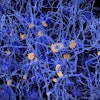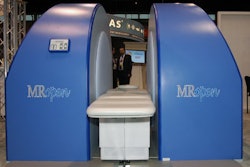MR stress perfusion imaging (MSPI) with adenosine is safe even for daily clinical use, according to researchers from Germany who used it in patients with suspected coronary artery disease.
Adenosine is an effective stress agent, and major side effects are both rare and reversible, concluded the team from Eberhard Karls University in Tübingen.
MSPI "is increasingly used for the detection of coronary artery disease," said lead investigator Dr. Bernard Klumpp at the 2006 RSNA meeting in Chicago. "Adenosine increases the potassium permeability of the cell membrane and inhibits cellular calcium uptake. The result is coronary vasodilation, which causes coronary artery steal effect. This enables the visualization of myocardial perfusion."
One potential side effect is prolongation of the PR interval on the ECG, or atrioventricular (AV) block. Minor side effects include heading and heating sensations.
The investigators sought to evaluate the safety of adenosine as a stress agent for MSPI regarding its suitability for daily routine use.
The group performed MSPI on 140 patients (mean age, 63.8 years) with known or suspected coronary artery disease, all presenting with stable angina pectoris, Klumpp said. Those with high-grade aortic valve stenoses, hypertrophic obstructive cardiomyopathy, acute myocardial infarction, asthma bronchiale, or general contraindications for MRI were excluded, he said.
For MSPI, a 2D turbo FLASH sequence was acquired in a short-axis orientation with three to four slices (0.1 mmol Gd-DTPA/kg body weight at 4 mL/sec, 140 μg adenosine/kg bwx min. over four min.). Myocardial function was assessed using steady-state free-precession sequences. Images were acquired on a Magnatom Sonata 1.5-tesla scanner (Siemens Medical Solutions, Malvern, PA).
"Ten minutes after rest perfusion, the stress perfusion series was acquired using the identical (inversion-recovery turbo FLASH) sequence," Klumpp said. "Total exam time was about 45 minutes."
Safety monitoring included permanent ECG monitoring throughout the exam, and blood pressure and heart rate measurements.
Stress-induced malperfusion was detected in 94 of the 140 patients. "There were 69 patients with delayed enhancement representing myocardial infarction," Klumpp said. "Heart (rate) increased from a mean 61.6 bpm (± 9.2) at rest to 78.4 (± 14.8), which is a highly significant increase (p < 0.05)."
The mean blood pressure did not change significantly (136/73 at rest, 133/71 at stress, p > 0.1). As for side effects, adenosine caused bronchospasm in one patient and third-degree AV block in two patients, who were immediately reversed when the adenosine infusion was stopped. Headache occurred in 91 patients, and heat sensations occurred with adenosine infusion in 112 patients.
"Stress perfusion with adenosine MSPI is a safe procedure suitable for daily routine use," Klumpp concluded. "Adverse events can be detected reliably. Minor adverse events are frequently observed but harmless. Major adverse events are rare and reversible after stopping adenosine infusion, requiring no further treatment."
Another new study, from the MRI center at St. Gertrauden Hospital in Berlin, concluded that adenosine stress perfusion MR is also useful for detecting small-vessel disease -- that is, patients testing positive for myocardial ischemia but without significant coronary artery stenosis at coronary angiography.
Bernhardt et al examined 317 patients with MRI who had suspected myocardial ischemia and clinical indications for coronary artery stenosis at angiography. Perfusion deficits were detected in 93% of the patients. Seventy-eight percent of the patients with delayed perfusion were considered to have relevant coronary macroangiopathy. All had significant calcium stenosis, and 22% were considered to have small vessel disease.
"Stress perfusion (cardiac MR) allows noninvasive differentiation between patients with significant (coronary artery) stenosis and patients with (small-vessel disease) caused by hypertension and/or diabetes based on the temporal and spatial extent of perfusion deficits," wrote the authors (International Journal of Cardiology, December 27, 2006).
By Eric Barnes
Auntminnie.com staff writer
January 16, 2007
Related Reading
Early administration of adenosine improves MI outcomes, November 29, 2006
MRI discriminates new myocardial infarction from old infarct scar, November 28, 2008
Adenosine infusion may limit infarct size after myocardial infarction, June 4, 2005
Coronary calcification linked to decreased coronary vasodilation, September 6, 2006
Copyright © 2007 AuntMinnie.com


.fFmgij6Hin.png?auto=compress%2Cformat&fit=crop&h=100&q=70&w=100)





.fFmgij6Hin.png?auto=compress%2Cformat&fit=crop&h=167&q=70&w=250)











